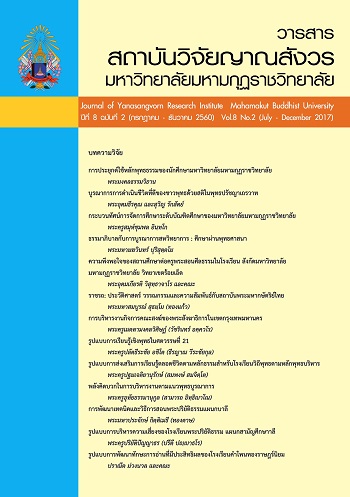Influences of Dynamic Capability and Innovative management Affecting Competitiveness of Buddhist Printing Press Business in Thailand
Main Article Content
Abstract
The objectives of this research were 1) to study effects of dynamic ability and innovative management to the competitive ability of Buddhist publishing business in Thailand, and 2) to study of the confirmatory factor analysis for building a structural equation model from empirical data in terms of the competitive ability of Buddhist publishing business in Thailand. This research is the quantitative research. The research instruments consisted of questionnaire that was checked its content validity by specialists and then calculated its IOC and Conbrach’s reliability. The data were collected from 103 entrepreneurs of Buddhist publishing business in Thailand and then computed in form of the Structural Equation Model (SEM). The research findings were revealed that the dynamic ability had positive direct effect to the competitive economic ability. In addition, the dynamic ability had positive indirect effect to the competitive ability by having the innovative management as the mediator. After using the computer program to analyze SEM, it was found that all indicators were in line with the standardized criterions. Therefore, it can draw a conclusion that the results of this research are in line with the empirical data.
Article Details
References
วลัยลักษณ์ รัตน์วงษ์. (2555). ปัจจัยเชิงเหตุและผลของนวัตกรรมการบริการสำหรับธุรกิจนำเที่ยวภาคใต้ของไทย. ดุษฏีนิพนธ์ปริญญาเอก, สาขาการจัดการ, มหาวิทยาลัยสงขลานครินทร์.
Galunic, D. C., & Eisenhardt, K. M. (2001). “Architecturalinnovation and modular corporate forms”. Academy of Management Journal, 6,pp 1229–1249.
Hair, J. F., Black, W. C., Babin, B. J., & Anderson, R. E. (2010). Multivariate data analysis: a global perspective (7th ed.). Upper Saddle River, NJ: Pearson Prentice Hall.
Li, D.Y., and Liu, J. (2014). Dynamic capabilities, environmental dynamism, and competitive advantage: evidence from China. Journal of Business Research, 67:2793-2799.
Protogerou, A., Caloghirou, Y., and Lioukas, S. (2005). Inside the black box’ of dynamic capabilities: defining and analyzing their linkages to functiuonal competences and firm performance. Industrial and Corporate Change,Copenhagen, Denmark ,27-29 June,31.
Rindova,V.P.,&Kotha,S.(2001).“Continuous "morphing": Competing through dynamiccap abilities, form, and function”. Academy of Management Journal, 44(6), pp1263-1280.
Sam The Rider.(2016). “Brief Situation of Thai Print Media 2016”. Nealson Company (Thailand). On-line. Available from Internet ,
Teece,D.J. & Pisano, G. & Shuen, A. (1997). Dynamic capabilities and strategic management. Strategic Management Journal, 18(7): 509.
Teece , D.J. (2007). Explicating Dynamic Capabilities : The Nature and Micro-foundations of (Sustainable) Enterprise Performance. Strategic Management Journal, 28 : 1319-1350.
Wong S.Y. & Chin K.S. (2007). Organizational Innovation Management : An Organization Wide Perspective. Industrial Management & Data Systems, 107(9), 1.


